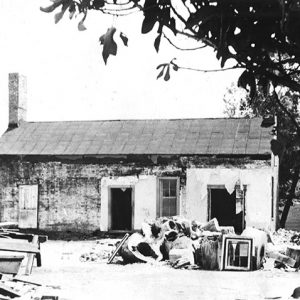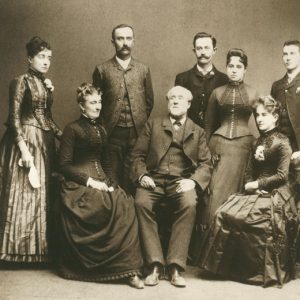calsfoundation@cals.org
Brownlee House
The Brownlee House is a one-story brick structure in a historically preserved part of Little Rock (Pulaski County). This Georgian vernacular cottage was built by Scotsman Robert Brownlee for his brother and his brother’s wife, James and Isabelle Brownlee, in 1847. Between 1939 and 1941, Louise Loughborough and Max Mayer renovated the Brownlee House and several other structures on Block 32 in addition to the Brownlee House on Lot 9 to create the Arkansas Territorial Restoration, today’s Historic Arkansas Museum.
Chester Ashley and his brother-in-law Roswell Beebe originally owned Lot 9. A deed of warranty dated February 16, 1842, states that Thomas Thorn sold Lot 9 to James McVicar. On July 12 of the same year, McVicar conveyed the property to stonemason Robert Brownlee, who had immigrated to America after reading about the Great Fire of 1835 that destroyed much of New York City. After time in New York and North Carolina, he moved to Little Rock in 1837. Organizing as McVicar and Company with fellow stonecutters James McVicar and John Cooper, Brownlee quarried stone for the construction of Arkansas’s original state capitol building in Little Rock, now known as the Old State House Museum. His brother James followed him to Little Rock in 1842 and found work as a blacksmith.
James and Isabelle lived in the Brownlee House rent free until 1852. A woman enslaved by the Brownlees, known as Tabby, most likely lived in the detached Brownlee kitchen with another unidentified enslaved person. Robert Brownlee recorded a detailed account of life in the Brownlee household while under the care of his brother and sister-in-law, as he recuperated from a near-fatal mining explosion in 1848. He noted that Isabelle was homesick and unsatisfied living in Little Rock. Eventually Isabelle and James moved back to Scotland. James auctioned off his household possessions, which mention household and kitchen furniture in addition to twenty-five bee hives hollowed out from tree trunks.
The house rests on a fieldstone foundation and is topped by a gable roof. The wooden mantels inside the parlor and bedroom were marbleized using a faux finish painting technique. This was a popular design trend in the nineteenth century, and many painters in Little Rock advertised the variety of woods and stones they could replicate, from Egyptian marble to English live oak.
This brick cottage follows the symmetrical 1840s style of a central hall bordered by two rooms of equal size. The main entrance faces Cumberland, and three rear doors provide easy access to outbuildings, including the Brownlee kitchen, a smokehouse, and a privy. The original smokehouse was demolished during the 1939 restoration, but it was rebuilt in 2005, using photographic and archaeological evidence.
On April 12, 1850, Robert Brownlee listed the house for sale, along with his other properties. He advertised the house in the Arkansas Gazette as follows, “A New 1-story Brick Dwelling-house, on the west side of Cumberland, between Cherry and Mulberry streets, and Lot No. 9, in Block No. 32, on which it is situate [sic], in the city of Little Rock. The house contains two nearly finished rooms, separated by a spacious and airy hall. On the premises are an excellent kitchen, smoke-house with cellar underneath, and other out-buildings, together with a well of the best water in the city. This property rents for $150 per annum.”
In July 1852, Brownlee sold the property to Dr. Roderick L. Dodge. Until the 1939 restoration, the Brownlee House underwent various uses, including as a boarding house for women and a single-family dwelling.
The Brownlee House is part of the Arkansas Territorial Restoration District, which was listed on the National Register of Historic Places on May 31, 2019.
For additional information:
“Archeology of Women’s Lives at the Brownlee House.” Arkansas Archeological Survey, University of Arkansas. https://archeology.uark.edu/womens-lives-brownlee-house/ (accessed June 25, 2021).
“Arkansas Territorial Restoration Historic District.” National Register of Historic Places registration form. On file at Arkansas Historic Preservation Program, Little Rock, Arkansas. Online at https://www.arkansasheritage.com/docs/default-source/national-registry/atrhd-pdf.pdf?sfvrsn=ba094ba1_0 (accessed June 25, 2021).
Bennett, Swannee. “An Interpretive Narrative and Furnishings Plan for the Arkansas Territorial Restoration Historic Structures.” Historic Arkansas Museum Archive, Little Rock, Arkansas.
Brownlee, Robert. An American Odyssey: The Autobiography of a 19th-Century Scotsman, Robert Brownlee, at the Request of His Children. Napa County, California, October 1892. Edited by Patricia A. Etter. Fayetteville: University of Arkansas Press, 1986.
Historic Arkansas Museum. http://www.historicarkansas.org/ (accessed June 25, 2021).
Worthen, William B. “Louise Loughborough and Her Campaign for ‘Courage and Fineness.’” Pulaski County Historical Review 40 (Summer 1992): 26–33.
———. “Restoring the Restoration.” History News 39 (November 1984): 6–11.
Victoria Chandler
Historic Arkansas Museum










Comments
No comments on this entry yet.